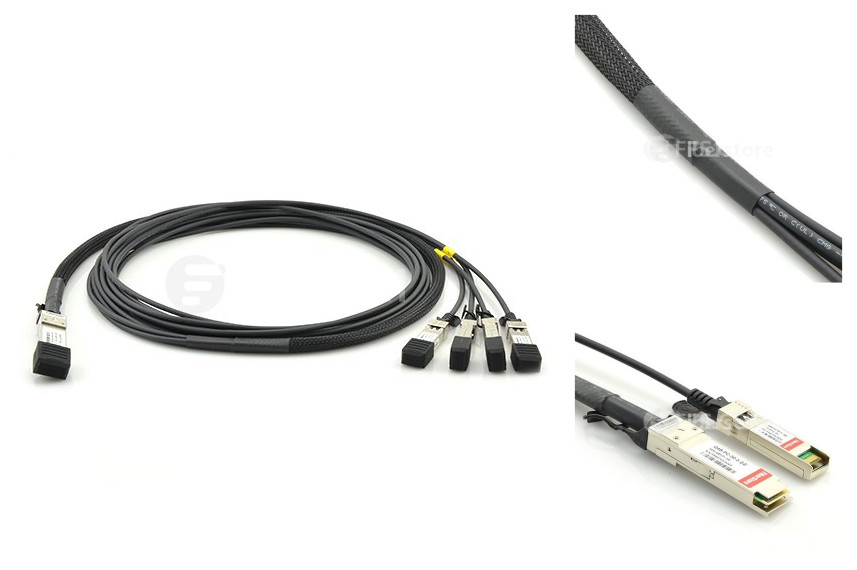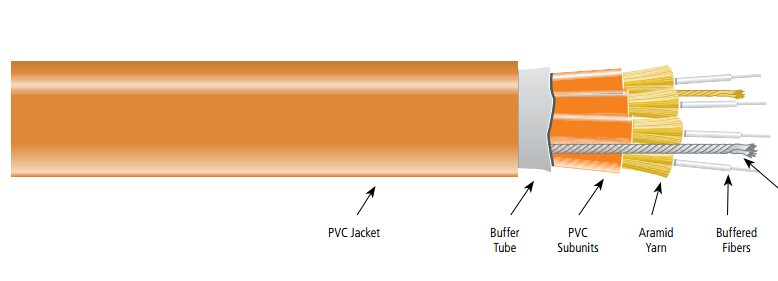June 17, 2016
When talking about direct attach cables, we may come across breakout cable, such as Cisco QSFP+ breakout cable. There are many kinds of breakout cables, and they are suitable for various applications. For example, a Cisco QSFP-4SFP10G-CU5M compatible QSFP+ to 4 SFP+ passive direct attach copper breakout cable, as shown below, connects to a 40G QSFP+ port of a Cisco switch on one end and to four 10G SFP+ ports of a Cisco switch on the other end, and is used for very short distances and offers a very cost-effective way to connect within racks and across adjacent racks. Other than copper breakout cable, there is also fiber breakout cable. What is fiber breakout cable? How much do you know about fiber breakout cable? In this post, a brief introduction to fiber breakout cable will be given.

Breakout-style fiber optic cable, also called fiber breakout cable or fiber fan-out cable, is an optical cable which contains several jacketed simplex optical fibers package together inside an outer jacket. It differs from a distribution-style cable, in which tight-buffered fibers are bundled together, with only the outer cable jacket of the cable protecting them. The design of breakout-style cable adds strength for ruggedized drops, however the cable is larger and more expensive than distribution-style cable. The structure of fiber breakout cable (shown as the figure below) ensures a long life. A fiber breakout cable consists of outer jacket, tap binder, breakout fiber assembly (tight-buffered fiber surrounded in aramid yarns and jacketed), strength member, and ripcord. For easier handling, it also features an easily strippable 900µm coating. Both the PVC and plenum cables are rated for fire safety.

- The key purpose of fiber breakout cable is that one can "break out" several fibers at any location, routing other fibers elsewhere.
- Each numbered fiber sub unit is protected by a layer of aramid yarn and encased in a FRNC/LSNH jacket. The individual sub units are cabled and then jacketed with a flame resistant FRNC/LSNH compound. Each fiber uses either the tight buffer technology or semi-tight buffer technology for excellent fiber stripping.
- Each fiber of a breakout cable has its own jacket and aramid strength elements, so each fiber is extremely strong and rugged.
- Fiber breakout cable is available in a variety of designs that will accommodate the topology requirements found in rugged environments. Fiber counts from simplex to 256 are available.
- A tight buffer design is used along with individual strength members for each fiber. This permits direct fiber cable termination without using breakout kits or splice panels.
- Due to the increased strength of Kevlar members, fiber breakout cables are heavier and larger than the telecom types with equal fiber counts.
- A fiber breakout cable offers a rugged cable design for shorter network designs. This may include LANs, data communications, video systems, and process control environments.
- Fiber breakout cable is extremely versatile and suitable for use in riser and plenum indoor applications. You can use it in backbone and horizontal runs.
- Each fiber is individually reinforced, so you can divide a breakout cable into individual fiber lines, which enables quick connector termination and eliminates the need for patch panels.
- Fiber breakout cable can be more economical because it requires much less labor to terminate. You may want to choose a cable that has more fibers than you actually need in case of breakage during termination or for future expansion.
- Fiber breakout cable offers advantages over standard patch cords because it eliminates the need for a fiber-optic ducting system.
Fiber breakout cables are typically used for indoor applications, between an optical distribution frame and an electronic equipment rack, or between two electronic equipment racks. These cables are particularly effective when equipment racks are distributed over a large area (for example several floors in a large building). The end of the breakout cable behaves like a standard single pigtail. The outer jacket of the cable can be stripped. Fiber breakout cables are used to carry optical fibers that will have direct termination to the equipment, rather than being connected to a patch panel. Covered with an outer jacket, these cables are ideal for routing in exposed trays or any application requiring an extra rugged cable that can be directly connected to the equipment. And they are also suitable for pre-terminated cable assemblies.
Fiber breakout cables are ideal for installations requiring an extremely rugged and reliable cable design where maximum mechanical and environmental protection are necessary. And fiber breakout cables have many obvious advantages, such as cost savings, direct termination to sub cable, which eliminates the need for patch panels and patch cords and reduces connector loss, and easy installation and high crush resistance.
Posted by: jowang at
02:34 AM
| No Comments
| Add Comment
Post contains 802 words, total size 7 kb.
35 queries taking 0.0261 seconds, 70 records returned.
Powered by Minx 1.1.6c-pink.









